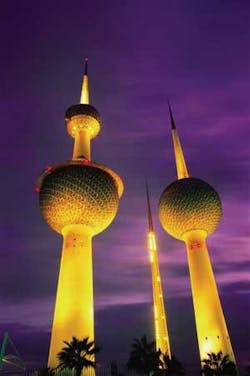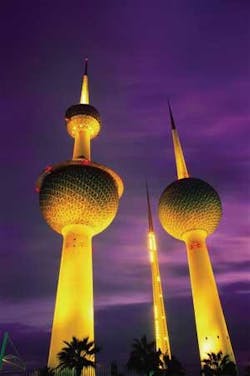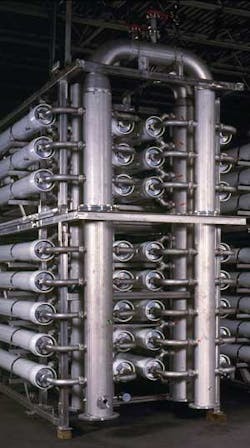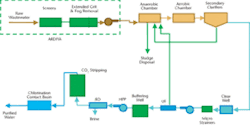Sulaibiya water reuse project begins full operations
The world’s largest membrane-based water reuse project begins full operations this month in Kuwait, as part of a 30-year concession involving the The Kharafi Group of Kuwait and the US company Ionics, Inc.
The Sulaibiya facility will begin supplying an alternative source to potable water in Kuwait in December 2005. Construction was just completed in November, so the full plant will start converting 100 million gallons per day (mgd) of municipal effluent to 85 mgd of high quality reclaimed water. Treatment capacity can be expanded to treat 160 mgd.
In May 2001, the Kuwait government awarded a 30-year concession to recover municipal wastewater from Kuwait City and the surrounding area. The winning consortium includes Mohammed Abdulmohsin Al-Kharafi & Sons (The Kharafi Group) of Kuwait and the US company Ionics, Incorporated. The consortium was established specifically to design, build, own, operate and maintain the wastewater treatment facility at Sulaibiya near Kuwait City. The purified water from the Sulaibiya facility will be used for non-potable uses that are currently affecting the drinking water supply by blending with brackish water to better exploit existing brackish water distribution facilities.
The design team opted to use well-proven processes. Municipal effluent is given preliminary treatment at Ardiya and then piped 25 km to the Sulaibiya facility. A conventional biological wastewater treatment plant treats the effluent to better than secondary effluent quality. The secondary effluent then flows to the water reclamation plant, which uses ultrafiltration (UF) and reverse osmosis (RO) to further purify the water for reuse. Sludge from the wastewater treatment plant is treated to allow for disposal by landfill, incineration, or by composting.
The water quality used as the basis of design and the projected treated water quality are detailed in Table 1. Plant influent is typical domestic sewage. The wastewater treatment plant design average monthly value is 5 mg/l BOD and 10 mg/l TSS, considerably better than the original requirement of 20 mg/l BOD and 20 mg/l TSS. However, the water reclamation plant is designed to accommodate peaks in water quality due to upsets in performance of the wastewater treatment plant. The average total dissolved solids (TDS) in the feed is 1,280 mg/l, and the plant product will be less than 100 mg/l, significantly better than World Health Organization (WHO) potable water guidelines.
null
The Kharafi Group’s extensive experience with constructing and operating sewage treatment plants in Kuwait helped in the design of the wastewater treatment plant design. Preliminary treatment at Ardiya consists of particulate and grit removal, and oil and grease removal. The waste is then pumped to Sulaibiya. The plant consists of anaerobic, anoxic and aerobic systems for enhanced biological removal of nitrogen and phosphorus, plus secondary clarifiers. To minimise variation in flow, buffer volume was taken into account in the design of the facilities at Ardiya, the aeration basins and the clarifiers. Sludge treatment involves aerobic digesters and drying beds. This process is well-proven in Kuwaiti conditions, and was selected for low odour, low operation and maintenance costs, minimum sludge quantity for disposal, and the environmental benefit of being able to use the sludge as a soil conditioner or organic fertiliser.
The water reclamation plant is designed to treat 375,000 m3/day (100 mgd) of secondary effluent, which will be prefiltered with disk filters and then fed to the ultrafiltration system. UF product feeds a reverse osmosis plant, and UF waste is recycled to the wastewater treatment plant. The UF system will treat 100% of the flow after biological treatment since the UF waste is recycled; hence the feed to the RO system is also 100 mgd. The RO plant is designed for 85% water recovery, so the expected production rate is 85 mgd.
Membrane filtration was selected to provide robust pretreatment of the secondary-treated municipal effluent before being fed to the RO. Membrane filtration was selected over conventional tertiary clarification and filtration because it reduced the plant chemical consumption and could guarantee that low turbidity water is fed to the RO. It is expected that better quality pretreatment to the RO will lead to longer membrane life, lower operating pressure, and reduced cleaning frequency for the RO system. Also, the combination of UF and RO removes bacteria and pathogens and provides potable quality water suitable for agriculture or groundwater recharge.
Bids for the membrane filtration system were solicited from major suppliers of membrane filtration equipment. UF technology from Norit (Netherlands) was selected both for favourable life cycle costs and, since this is a UF membrane, for the better quality of water to RO membranes. The ultrafiltration plant will use Norit’s X-Flow membranes, which are capillary hydrophilic hollow fibres. These membranes are packaged in 8” x 60” membrane elements that provide 35 m2 of membrane area per element. Four membrane elements are placed inside a membrane housing, and thirty-two membrane housings are installed in each UF unit. This plant consists of 68 skids, each with 32 membrane housings for a total of 8,704 membrane elements. The plant will be operated continuously and is fully automatic, with very little operator attention required.
The UF units are operated individually. Each unit is backwashed regularly, whereby all suspended matter that is being retained by the membranes is removed from the plant. The backwash water is pumped back upstream of the WWTP to achieve the highest possible overall water recovery for the plant. Occasionally, a low dose of chemicals will be added during a backwash. This Chemically Enhanced Backwash (CEB) will remove any matter that may have adhered to the membrane surface and is not removed by a hydraulic backwash alone. Since the backwash and CEB actions are scheduled on an individual unit basis, taking only a minor section of the plant out of filtration mode, the continuous flow of effluent from the biological plant can be accommodated.
The effluent fed to the UF first passes through a disk filter, after which a small amount of coagulant is added to coagulate fine particulates and possibly allow some TOC removal to facilitate the operation of the plant. The SDI of the UF product will be below 2, an important criterion for the RO plant performance. Previous experience treating secondary municipal effluent with UF has shown that SDI values of less than 1 are possible.
The salinity of the municipal effluent has an average monthly value of 1,280 mg/l TDS, with a maximum value of 3,014 mg/l. RO will be used to desalinate the water to 100 mg/l TDS, as well as provide a second barrier to bacteria and viruses.
RO technology is well proven for desalinating municipal effluent. The system will consist of 42 identical skids in a 4:2:1 array. Approximately 21,000 membranes will be required for this project. The RO system is limited to operating at 85% recovery and will be limited for this plant by calcium phosphate precipitation, which can frequently be the limiting factor for water recovery in membrane systems desalinating municipal effluent. The RO product will pass through a stripper to remove carbon dioxide to adjust pH with a minimum amount of caustic before distribution, and the product will then be chlorinated before leaving the plant. RO brine is disposed of to the Persian Gulf.
The Kharafi Group will operate and maintain the wastewater treatment plant and Ionics will operate the water reclamation facility. To ensure ease of operation, operator input was solicited at design stage to ensure ease of operation. The treatment steps have been selected to minimise the use of power and chemicals, and are simple to operate and maintain.
A key to successful operations is to employ highly trained and motivated staff. Operating personnel will include a number of managers, chemists and engineers, as well as qualified technicians and labourers. Training to the appropriate level is being provided at manufacturers’ premises and on-site during commissioning and testing. During start-up and commissioning of the facility, a total of 42,000 person-days of training are expected to occur. Continuous performance monitoring of the plant will be necessary to ensure compliance with the required standards and for process monitoring and control. There will be on-line monitoring of flow and water quality parameters. Key process parameters will be calculated and trended to ensure that the plant is performing up to expectations. An on-site laboratory will be fully equipped to carry out required water analyses.
This project is expected to provide the benchmark and catalyst for the successful implementation of similar build, operate and transfer (BOT) projects in the Middle East region, which are particularly relevant due to the scarcity of water in the area. As it was recently named by Project Finance magazine, this truly is the “Wastewater Deal of the Year.”
Author’s Note
David Gagneis a project manager at Ionics Incorporated, based in Watertown, Massachusetts, USA.




